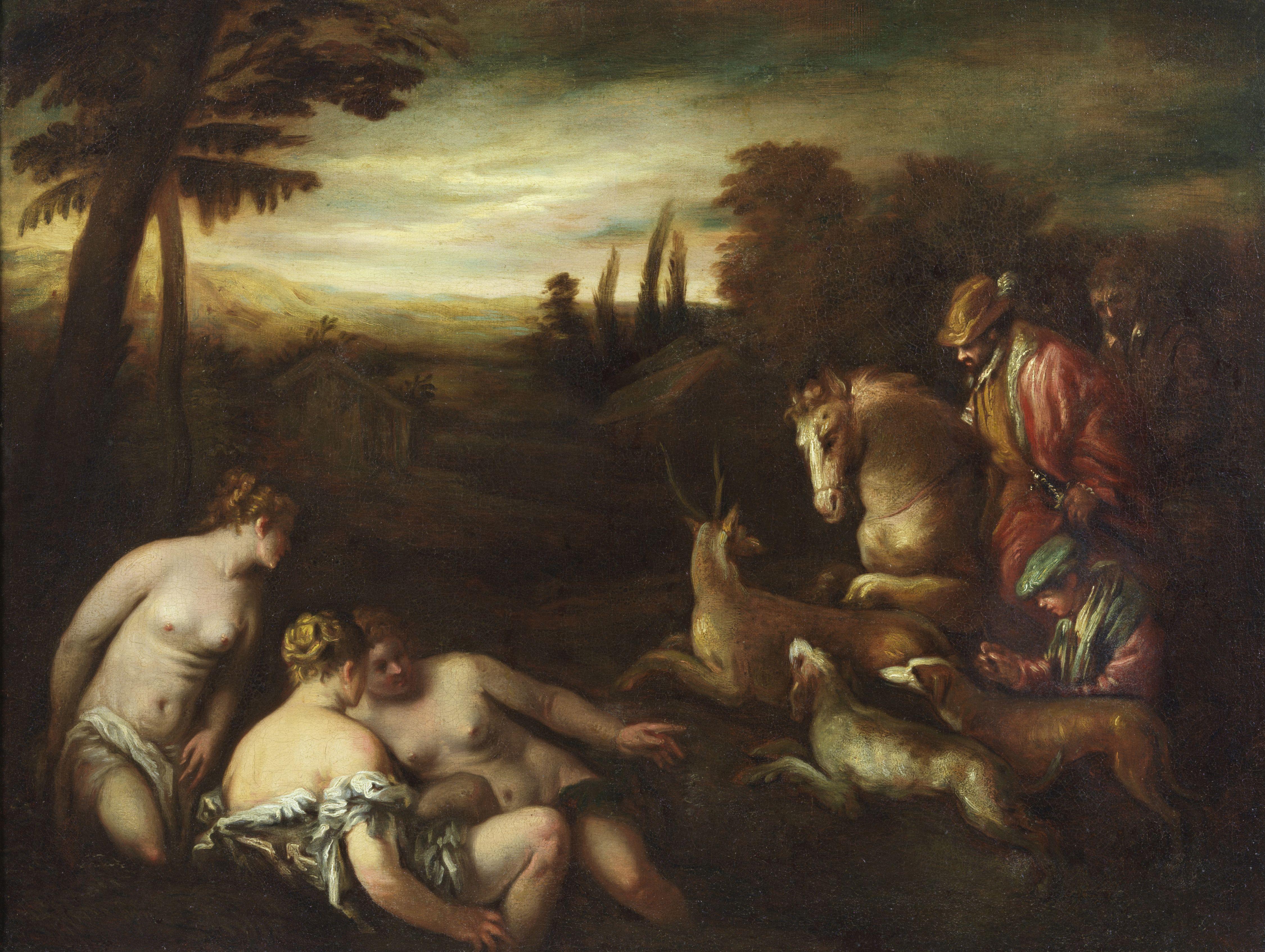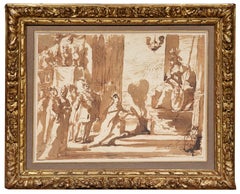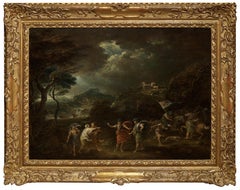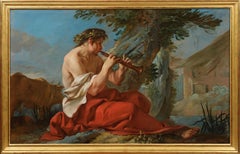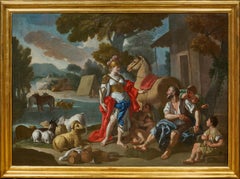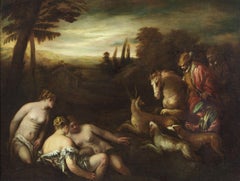Items Similar to Diana and Actaeon, a Mannerist painting after Joseph Heintz the Elder
Want more images or videos?
Request additional images or videos from the seller
1 of 14
Diana and Actaeon, a Mannerist painting after Joseph Heintz the Elder1st quarter of the 17th century
1st quarter of the 17th century
$21,473.33
£15,873.47
€18,000
CA$29,784.63
A$32,471.76
CHF 17,157.45
MX$399,326.23
NOK 213,339.08
SEK 200,830.48
DKK 137,060.74
About the Item
This painting seduced us with its rich colors. Depicting Diana and her companions surprised by Actaeon, it was inspired by an engraving by Aegidius Sadeler II after a painting by Joseph Heintz the Elder now in the Kunsthistorisches Museum in Vienna.
This subject was a huge success and many artists, all anonymous, were inspired by this engraving. The vivid colors used in this painting suggest that it was probably executed in the first quarter of the 17th century by a Nordic artist, perhaps during his stay in Italy.
1. Joseph Heintz the Elder, a great artist of the Mannerist school
Joseph Heintz the Elder was born in Basel in 1564, where he apprenticed in the studio of Hans Bock the Elder (1550 - 1624). He was also inspired by the works of Hans Holbein the Younger, who had stayed in the city between 1515 and 1526.
In 1583 Joseph Heintz went to Italy and became a pupil of Hans von Aachen in Rome, before travelling to Florence and then Venice. In 1591, he was called to the court of Rudolf II in Prague, where he became his official portraitist. His stay in Prague lasted only two years, as he then returned to Italy to make copies of ancient works for the emperor before settling in Augsburg, where his son, also called Joseph, was born in 1600. His son in turn became a painter under the name of Joseph Heintz the Younger.
2. From the Vienna painting to the engraving by Aegidius Sadeler II
The original painting by Joseph Heintz the Elder is thought to have been painted between 1590 and 1600. It may have been commissioned by Rudolf II, as it reflects his taste for mythological scenes tinged with eroticism. It is now in the Kunsthistorisches Museum in Vienna (ninth picture in the gallery).
This painting enjoyed a certain renown very early on, as it was engraved by Aegidius Sadeler II (1570 - 1629), an Antwerp engraver who settled in Prague in 1597 (tenth picture in the gallery.
Although the engraving is faithful to the painting by Joseph Heintz the Elder, it differs in a few details, all of which are later reproduced in our painting (as in most other versions painted after this engraving). Starting from the left, we can see that the scabbard hanging in the tree is oriented differently, that the tree behind Actaeon has become straight, and that a tree has been added to the right above the rock forming a sort of grotto. While the engraver has emphasized the muscularity of the bodies, he has given Actaeon a fuller head of hair, and quite significantly reshaped the face of the woman standing on the far right.
3. Description of our painting
The scene depicted is inspired by a famous episode from Ovid's Metamorphoses (III 138-252). After a day's hunting, Actaeon, a young hunter, stumbles upon the sacred grotto where the goddess Diana and her nymphs are bathing. Furious at having been seen, Diana sends him a few drops of water that cause him to transform into a stag. Actaeon the hunter becomes a hunted beast, and he is eventually devoured by his hounds.
Joseph Heintz focused his painting on the representation of the group formed by the goddess, wearing her attribute (a crescent moon) and leaning forward to spray Actaeon, and her nymphs. Some of them are dressing hastily, while others are still enjoying this moment of rest.
The only notable change made by our painter to the engraving is to have crowned Actaeon's head with stag horns; this variant also appears in other copies made after Sadeler's engraving.
This painting is both rudimentary and sophisticated. The picture is painted directly onto the panel without any preparatory layer to soften the striations on the wood. The bodies, whose joints are briefly outlined with a few black lines, are drawn in a vigorous and geometric manner. But the interest - and the delight - of our painting lies in the very rich range of colors chosen to illustrate this episode.
Starting from a black and white engraving, it is likely that our painter had never seen the delicate green and pink polychromy of the original painting. In this choice of colors he demonstrated a real capacity for innovation, modulating the bodies of the nymphs from milky white to more amber tones and distributing the strident colors characteristic of Mannerism in the fabrics: carmine red, parma, orange or aniseed green.
One detail is highly representative of both the narrative verve of Heintz the Elder and our painter's taste for color. Unaffected by the surrounding tumult, a blonde beauty contemplates herself in a mirror while trying on a hat. Behind her is the most charming detail of our painting: a turbaned nymph who, like a child, hides behind the three fingers of her hand.
This close-up shows both the painter's skill at rendering detail (in the delicacy of the fingers partly covering the nymph’s face) and his immense skill as a colorist, since he does not hesitate to introduce a bright aniseed green alongside the astonishing azure blue cape (lined with orange!) that is resting on the lap of our blonde beauty.
4. The success of a theme spread through engraving
The engraving of Heintz the Elder’s painting ensured the success of this scene, which was widely reproduced: Marco Cannone, whom we would like to thank for his contribution, has listed 22 faithful copies, all of which were executed by anonymous artists after Sadeler's engraving (6 are on copper, 6 on wood, 9 on canvas and one on parchment). The two best-known copies are kept in two Italian museums, the Accademia in Venice and the Galeria Nazionale in Rome.
The only difference between these two copper plate versions is the color of the fabrics. In these versions, the nude bodies are closer to the original work, while in our painting they are much closer to the muscular treatment of the engraving, accentuating the Mannerist flavor of our painting.
5. Framing
We chose an Italian frame from the 17th century, whose auricular patterns are particularly well-suited to accompany this debauchery of flesh and swirl of colors.
Main bibliographical reference :
Jürgen Zimmer - Joseph Heintz der Ältere als Maler (1564 -1609) - 1971
- Creation Year:1st quarter of the 17th century
- Dimensions:Height: 20.88 in (53.04 cm)Width: 26.07 in (66.22 cm)
- Medium:
- Movement & Style:
- After:Joseph Heintz the Elder (1564 - 1609, Swiss)
- Period:
- Condition:Dimensions : 14 3/8‘’ x 19 13/16 ‘’ (36.5 x 50.3 cm) - Framed: 20 7/8’’ x 26 1/16’’ (53 x 66 cm) 17th century Italian carved and gilded wood frame in auricular style Provenance: private collection, Parma - Italy.
- Gallery Location:PARIS, FR
- Reference Number:1stDibs: LU1568212417162
About the Seller
5.0
Vetted Professional Seller
Every seller passes strict standards for authenticity and reliability
Established in 2020
1stDibs seller since 2021
10 sales on 1stDibs
Typical response time: 3 hours
- ShippingRetrieving quote...Shipping from: PARIS, France
- Return Policy
Authenticity Guarantee
In the unlikely event there’s an issue with an item’s authenticity, contact us within 1 year for a full refund. DetailsMoney-Back Guarantee
If your item is not as described, is damaged in transit, or does not arrive, contact us within 7 days for a full refund. Details24-Hour Cancellation
You have a 24-hour grace period in which to reconsider your purchase, with no questions asked.Vetted Professional Sellers
Our world-class sellers must adhere to strict standards for service and quality, maintaining the integrity of our listings.Price-Match Guarantee
If you find that a seller listed the same item for a lower price elsewhere, we’ll match it.Trusted Global Delivery
Our best-in-class carrier network provides specialized shipping options worldwide, including custom delivery.More From This Seller
View AllAllegory of the Treaty of Angoulême, a drawing attributed to Donato Mascagni
Located in PARIS, FR
We would like to thank Mrs. Ursula Verena Fischer Pace for suggesting the attribution to Donato Arsenio Mascagni.
We were immediately seduced by the rich tonalities of this allegory...
Category
1620s Old Masters Figurative Drawings and Watercolors
Materials
Ink
Macbeth and the Three Witches a Painting on Panel by Francesco Zuccarelli
By Francesco Zuccarelli
Located in PARIS, FR
This painting, created during Zuccarelli's stay in England, represents the decisive moment when Macbeth, together with Banquo, meets the three witches who announce that he will be Ki...
Category
1760s Old Masters Landscape Paintings
Materials
Oil, Wood Panel
Mercury and Io, a rediscovered painting by Jean-Baptiste Marie Pierre (ca. 1740)
Located in PARIS, FR
We would like to thank Mr. Nicolas Lesur for confirming the autograph nature of the entire composition after a direct examination of the painting on November 27, 2024.
This painting...
Category
1740s Old Masters Figurative Paintings
Materials
Canvas, Oil
Erminia and the Shepherds, a painting by Francesco de Mura (Napoli 1696 - 1782)
By Francesco de Mura
Located in PARIS, FR
In this masterly painting, Francesco de Mura presents the meeting of Erminia and the shepherds, a famous episode taken from the seventh canto of Torquato Tasso's Jerusalem Delivered....
Category
1760s Old Masters Figurative Paintings
Materials
Canvas, Oil
Stag Hunting in the Vicinity of Nuremberg by a German Artist Peter von Bemmel
Located in PARIS, FR
This small landscape shows a hunting scene: two riders are chasing a stag with their dogs at the edge of a forest. Signed by Peter von Bemmel, it is typical of the production of this...
Category
1720s Old Masters Landscape Paintings
Materials
Copper
Frieze of antique figures, a drawing by the sculptor Antoine-Denis Chaudet
Located in PARIS, FR
Faithful to the neo-classical taste, sculptor Antoine-Denis Chaudet presents us with a frieze of antique figures executed in gray wash over pencil strokes, which is likely inspired b...
Category
Early 1800s Old Masters Figurative Drawings and Watercolors
Materials
Paper, Pencil, Ink
You May Also Like
Diana Boullogne Mythological Paint Oil on canvas old master 17/18th Century
Located in Riva del Garda, IT
Bon Boullogne (Paris, 1649 - Paris, 1717) workshop of
Episodes from the myth of Diana
oil painting on canvas
Dimensions: 84 x 114 cm.
with antique frame 100 x 132 cm.
The beautiful painting proposed shows a series of episodes taken from the myth of the divinity Diana, the Roman divinity of hunting, forests and wild animals, masterfully captured in this valuable painting, which shows a luxuriant wood, a favorite place of the divinity, as a theater of his adventures.
The composition opens, on the left, with a sort of presentation of the divinity, portrayed as an attractive young girl, surrounded by her faithful Nymphs, one of whom holds her quiver with arrows, and by one of her beloved dogs. hunting her.
The 'story' continues in the central part where we can see the divinity during a wild boar hunt...
Category
Late 17th Century Old Masters Paintings
Materials
Oil
$8,457 Sale Price
20% Off
17th Century Diana and Actaeon Hernest Daret Mythological Oil on Canvas Green
Located in Sanremo, IT
Painting oil on canvas measuring 80 x 62 cm without frame and 105 x 82 cm with a contemporary frame by the painter Ernest daret, depicting the myth of Diana and Actaeon.
According t...
Category
1690s Italian School Figurative Paintings
Materials
Canvas, Oil
Landscape with a Mythological Story of Diana and Actaeon 1610
Located in Rome, IT
Important late 16' early 17' century painting By Giovanni Battista Viola with finely carved gilt- wood frame.
Landscape with a Mythological St...
Category
16th Century Baroque Landscape Paintings
Materials
Paint
Important 17' Century Mythological Painting Diana and Actaeon Oil on Canvas
By Giovanni Battista Viola
Located in Rome, IT
Fascinating mythological story of Diana and Actaeon can be found in Ovid’s Metamorphoses.
Very important provenance from a royal collection. Fabulous finely carved gilt wood coeval frame .
Giovanni Battista Viola...
Category
17th Century Baroque Landscape Paintings
Materials
Oil
Important 17' Century Mythological Painting Diana and Actaeon Oil on Canvas
By Giovanni Battista Viola
Located in Rome, IT
Fascinating mythological story of Diana and Actaeon can be found in Ovid’s Metamorphoses.
Very important provenance from a royal collection. Fabulous finely carved gilt wood coeval...
Category
17th Century Baroque Landscape Paintings
Materials
Oil
Important 17' Century Mythological Painting Diana and Actaeon Oil on Canvas
By Giovanni Battista Viola
Located in Rome, IT
Fascinating mythological story of Diana and Actaeon can be found in Ovid’s Metamorphoses.
Very important provenance from a royal collection. Fabulous finely carved gilt wood coeval frame .
Giovanni Battista Viola...
Category
17th Century Baroque Landscape Paintings
Materials
Oil
